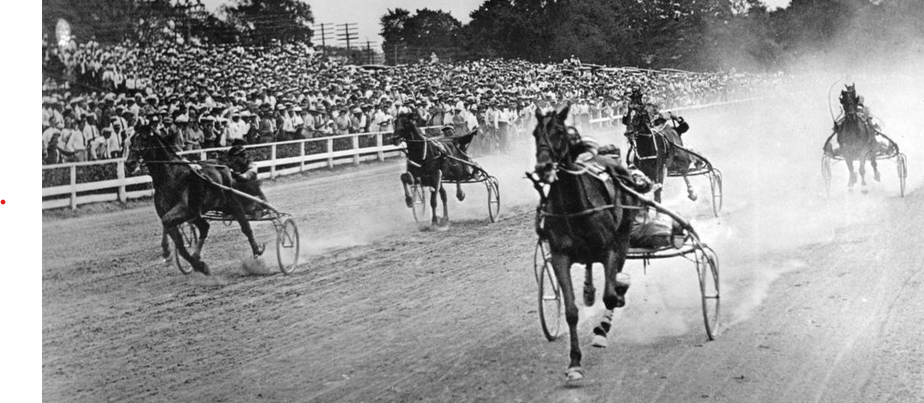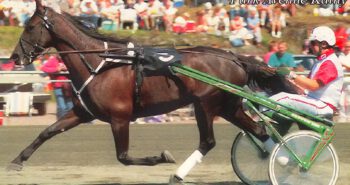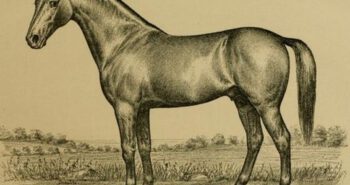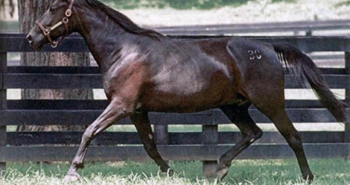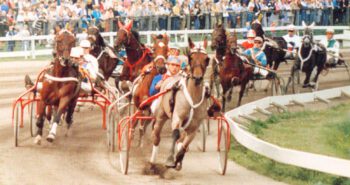The third filly to win the big race, The Marchioness was the first winner of a four-heat Hambletonian, the first winner with a female owner and the only one whose trainer and driver previously trained trotters for the Russian czar.
As a full sister to Protector, the fastest two-year-old of 1930, The Marchioness naturally became a pricey yearling despite later being described as having been a “slim, unpromising filly.” Selling for $2,300, the Peter Volo daughter was the most expensive yearling at the 1930 Old Glory sale at the end of November that year.
An early talent
Bestowed with as much talent as her one-year-older brother, it didn’t take long before the jungle telegraph was busy. In May the following year, newspapers reported that “word comes from Syracuse that the two-year-old filly The Marchioness, owned by RR Keeler, prominent banker of Auburn, NY, and trained by Will Caton, promises to be one of the star two-year-old trotters of the present season. (…) In a recent workout this filly trotted a mile in 2:16 (1.24,5) and later stepped a quarter in 30 a seconds – a 2:00 clip – at the end of a slower mile. Not having the advantage of being trained in the south during the past winter, where weather conditions permit regular training, the showing of The Marchioness is all the more remarkable, and if she continues to make the expected improvement, it will be no great surprise if she trots a sensational mile early in the racing season.”
Sickness delayed her debut slightly as she had to sit out when the Grand Circuit was in Cleveland. Instead making her debut in the two-year-old trot at Kalamazoo on Jul 17, 1931, The Marchioness finished third after 2-5 placings, Brevere winning both heats in 2:05 1/2 and 2:05 3/4 (1.18,0 and 1.18,2), respectively. In the first heat, The Marchioness only lost by a neck after sitting fourth at the half. Newspaper reports state she was timed the last half in 1:00 1/2, adding that “she is a much better gaited trotter than her famous brother.”
A week later she held off Calumet Chuck twice to win in two straight heats at Thorncliffe in Toronto, winning in the much slower 2:13 3/4 and 2:10 1/4 (1.23,1 and 1.20,9). On Jul 29, still in the Canadian metropolis, she met Brevere again. After the colt winning the first heat, The Marchioness took the next two to underline her credentials as one of the best in the crop, the second heat won in 2:07 1/4 (1.19,1). However, when Protector won the American Horse Breeders Senior Futurity at Charter Oak Park, his little sister had to settle for fifth after finishing fourth in both heats, Brevere again winning both.
World records
Moving to Goshen, the Good Time Stake was expected to be yet another showdown between Brevere and The Marchioness. However, after Brevere won the first heat in 2:03 1/4 (1.16,6), Hollywood Robin won the next two ahead of The Marchioness. However, it was just a little inconsistency that the filly was about to shake off. After winning in Aurora, IL, The Marchioness then took home the The Horse Review Futurity. In the first heat the filly went the last half in an impressive 59 1/2, the fastest half of the season, before easily holding off Truax-sons The Lad and Claumet Chuck in the race-off. The winning times, 2:04 3/4, 2:04 1/2, 2:08 1/2 and 2:07 1/2 (1.17,6, 1.17,4, 1.19,9 and 1.19,2), were also a four-heat world record for two-year-olds.
It what shaped up to be an excellent crop with several great trotters, there was one who stood out above the rest. As the Grand Circuit moved to Indianapolis, The Marchioness easily brushed aside the opposition in the junior Horseman Futurity, “in each of the two heats she set the pace and never relinquished the lead, with Brevere, from the White Stable” the contender.”
The Peter Volo-daughter was the massive pre-race favorite in the junior Kentucky Futurity and everything seemed to go according to plan when she won the first heat in 2:04 1/2 (1.17,4). In the second heat, however, she made a break at the head of the stretch and finished third, Maid McElwyn winning in a world record 2:02 1/4 (1.16,0). Then it was Calumet Chuck who stood out to win the next two heats – and the only race of his career – setting a new four-heat world record with 2:04 1/2, 2:02 1/4, 2:04 and 2:08 1/4 (1.17,4, 1.16,0, 1.17,0 and 1.19,7).
The critics are unsure
The loss notwithstanding, with five wins at 2 The Marchioness had shown enough at two to be considered one of the serious 1932 Hambletonian contenders: “The unprecedented number of fast two-year-olds which showed up in 1931 augurs well for the success of the Hambletonian Stake of 1932 (…) All of the prominent 1931 two-year-olds are Hambletonian-eligibles, including The Marchioness, sister to Protector, the prominent absentee among the 1931 eligibles. She won the Horse Review and Horseman Futurities and won a heat in the record-breaking four-heat battle at Lexington. She is not as sturdy as her famous brother, but is more attractively gaited than the champion and just glides along with little lost motion. However, if she races as well as he did the past season, the 1932 three-year-olds are in for a lot of trouble.” Perhaps somewhat surprisingly, though, Maid McElwyn was the 7:2 winter book favorite for the upcoming Hambletonian, followed by The Lad at 4:1, Calumet Chuck at 5:1, The Marchioness at 6:1 and Hollyrood Robin at 7:1. After losing out on what seemed like a sure Hambletonian win the year before with Protector [since the colt had not been kept eligible] the 55-year-old Caton would finally have a big chance at winning the biggest US race. The Northville, MI-native was not stranger to winning big races, though, as he had spent over 20 years in Russia winning all the biggest races there: for example, from 1905 to 1914, Caton won the Russian Derby an amazing seven times. The Marchioness would be his first Hambletonian candidate, though.
Not everybody were positive about The Marchioness ahead of her three-year-old season, though. According to Tom Gahagan, “in two of her nine races last year, The Marchioness was compelled to trot the limit of four heats, heartbreaking racing for a two-year-old, and after this grind some of the critics thought she might not come back as a three-year-old. However, in her recent work at North Randall she looked better than ever, turning in a mile in 2:04 1/2 (1.17,4) with the last half in 1:00.” The 1932 seasonal debut came in the Matron at the Cleveland-track North Randall on Jun 28. After winning the first heat, The Marchioness finished 4-3 in the next two as Brevere won both. She was pocketed and could not get out in the homestretch in the second heat. In the third she had the lead but was caught by Brevere and Calumet Chuck and lost fair and square.
The three-year-old mare would soon reestablish her superiority. In the Championship Stallion Stake at North Randall on Jul 5, The Marchioness was fifth in the first heat won by Brevere. Hollyrood Dennis took the second heat narrowly ahead of Caton’s mare, who put in a 58 1/2 seconds last half. This didn’t bother The Marchioness, though – instead of tiring from numerous heats she improved with each one. In the third heat she raced Hollyrood Dennis to a break at the half, took the lead and held on to win. Finally, in the raceoff between the three heat winners the leading Hollyrood Dennis went offstride halfway through the final stretch, and The Marchioness put in a strong finish, the last half in 59 seconds, to win. The winning times in the four heats were 2:02.3, 2:02, 2:02.3 and 2:04 (1.16,2, 1.15,8, 1.16,2 and 1.17,1) to established a new four-heat world record for three-year-olds. In doing so, The Marchioness showed not only a fast clip, but also the strength to carry it longer than her competitors.
The Caton-trained filly sat out the Dominion Stake at Fort Erie, ON – due to injury, it would later be revealed – impressively won in three straight heats by Hollyrood Dennis. It was a spectacular rise in prominence for the colt who was unraced at 2, yet firmly established as one of the Hambletonian favorites just two weeks prior to the big race. When the Grand Circuit moved to the Charter Oak Park in Hartford, The Marchioness and Hollyrood Dennis met up again. After the colt narrowly won the first heat, The Marchioness put in her trademark strong finishes to win the next two heats.
The crowning of the queen
The Hambletonian was seen as a duel between these two spectacular three-year-olds, though the rest were not discredited. According to Middletown Times Herald‘s article, “the victory of The Marchioness was clearcut, but it took four heats for the filly to subdue her rivals, and in the second heat she was fairly outtrotted by Hollyrood Dennis, who established a new stake record for the Hambletonian and a new season’s record for three-year-old trotters as well, when he won in 2:01 1/4 (…) After a few scores starter Phillips sent the field of seven on their way in the first heat, with Calumet Chuck, scoring at the pole, the early leader. Rounding the first turn, Egan took Brevere to the front, and then The Lad passed Brevere and was in front at the quarter in 31 seconds. They raced in this position past the half-mile post when both Hollyrood Dennis and The Marchioness moved to the front. The Marchioness was in command at the five-eights and led from that point home. Hollyrood Dennis made a big rounding the far turn, but a break in the stretch spoiled his chances, and The Marchioness coasted home in 2:04 1/2, with Invader second and Brevere third. The last half was trotted in 1:01, and the final quarter in 29 seconds.
The early pace was much faster in the second heat, and Calumet Chuck was again the early leader, but not for long as Crozier pulled Hollyrood Dennis out and passed the pacemaker at the quarter pole with The Marchioness hot on his trail. At the half Dennis was in front, The Marchioness second and Chuck third in 1:01 1/4, indicating that an extremely fast mile was almost certain. The Marchioness, trailing the leader, was in the most favorable position, but when Caton pulled her out in the stretch she could not catch the flying Hollyrood Farm colt, who hung on gamely and had a neck’s advantage at the finishing, the mile in 2:01 1/4 (1.15,4), the last half in just 1:00.
The third heat brought the surprise of the day when Hollyrood Dennis, after leading from the start until well through the stretch, made a bad break which interfered with The Marchioness, who did not get out of a pocket in time, and permitted Invader, racing on the outside, to come home an easy winner, while Will Dickerson brought the Arden Homestead colt, Calumet Crusader, home in second place. Invader had raced in fourth position most all the way and was clear of the leaders coming into the stretch.
Only the three heat-winners came back in the fourth and deciding round. Caton and Crozier forced Lyman Brusie, with Invader, to set the pace, which was slow to the half, but there all three turned on the steam, and while Invader gamely held his lead well into the stretch he could not stand off the terrific rush of The Marchioness and Hollyrood Dennis, both of them passing him about half way down the home lane. The Marchioness proved herself clearly the best, pulling away in the last few yards to win by an open length in 2:05 1/2 (1.18,0), last half in 1:00, final quarter in 28 1/2 seconds.”
For Caton, despite winning virtually everything in Russia, the Hambletonian win was the biggest of all. In an article in the Buffalo News he stated that “there was no victory as thrilling as winning the Hambletonian before a home crowd of 25,000 howling fans.”
Avenging her brother
It was also a revenge for missing out on the previous year. Protector, The Marchioness’s one year older full brother, was head and shoulders above the rest in his crop, but owner Keeler had so little faith in his colt at 2 that he didn’t bother to keep the colt eligible. He wouldn’t make the same mistake with The Marchioness. However, not long after Protector won the Kentucky Futurity in 1931, Keeler passed away from pneumonia. He would therefore never experience the Hambletonian win he had dreamt of, and instead his widow Anne became the first female owner of a Hambletonian-winner. Ralph Keeler had willed all of his horses to Caton, except for The Marchioness, the ownership of which went to his wife.
However, it could so easily have ended with a heartbreaking failure. As Tom Gahagan wrote in an article published in the Cincinnati Enquirer on Aug 21, 1932, “five weeks ago, after she had won the Championship Stallion Stake at North Randall, the Hambletonian chances of The Marchioness appeared at their lowest ebb. She injured a leg in a workout at Toledo and it looked like a bad injury, a strained muscle behind which caused much swelling, and more than one of the circuit followers predicted that she would not even get to the post for the Hambletonian.
Caton went to work on her and a week later was giving her slow work, but still the leg looked bad. It was only after nearly three weeks that he asked her for any speed, driving her in 2:06 1/2 (1.18,6) over the slow Rockinghim Park course; he repeated in about the same time over the same course the following week, then gave her her Hambletonian prep by starting her against Hollyrood Dennis at the Charter Oak Park, Hartford, where she won, although beaten by the colt in the fastest heat.
He worked her showly after shipping to Good Time Park, and the day before the race an experienced circuit follower assured me solemnly that “she’ll never get around that sharp first turn without making a break. She made only one break in the race, and that when she met with interference in finishing the third heat.”
Gagahan also raised the question of how the filly compared to her famous brother: “the writer asked Caton a few days ago if The Marchioness had more speed for a brush than Protector. ‘Yes, but in a different way’, was the answer. ‘When I pull the filly out for a drive she increases her speed gradually; when I gave Protector his head it was with the rush of a mad bull that he responded.’ And that is just the impression that the big colt gave: a smashing rush that simply annihilated all opposition. On the other hand the filly just apparently floats along; when she is working alone one needs a watch to convince himself that he is trotting at a record-breaking clip.”
A foregone conclusion
On Aug 25 followed an easy win in the Illinois State Futurity at Springfield. “The filly trailed past the half in each heat, then Caton sent her to the front and she won off by herself, her miles in 2:02 and 2:02 1/4 (1.15,8 and 1.16,0). Calumet Chuck beat Kashmary for the place each time in driving finishes.” Then came an equally easy win the in the Horseman Futurity at Indianapolis on Sep 6.
Having lost only one race all year, the Kentucky Futurity seemed a foregone conclusion. Indeed it was, but – again – it could so easily not have been. From the Lexington Herald, “when The Marchioness won the $14,000 Kentucky Futurity for 3-year-old trotters at the Kentucky Association running track yesterday afternoon, more than 6000 persons registered their enthusiastic approval of a victory predicted for months, but they received a distinct shock when the time of the two heats was announced as 2:02 3/4 and 2:02 (1.16,3, 1.15,8), probably the fastest times of the year, when everything is taken into consideration. (…) The greatness of The Marchioness’ victory was not known to the thousands who packed the stands, the clubhouse and the rail. They did not know that The Marchioness was lame; that she had injured her left hind leg by striking a sulky earlier in the week; that she came from behind twice to trot two great miles and finish a season of continuous victories, including the $60,000 Hambletonian. (…) The Marchioness trailed the field of four starters in the opening heat of the Futurity for three quarters, coming up fast on the outside to finish with a burst of speed that left no doubt as to her supremacy. The strains of “She was bred in Old Kentucky” floated through the air as she came flying down the stretch in the final heat, repeating the performance of her big brother, Protector, Futurity winner in Lexington last year.”
A final world record before going to Italy
In early October 1932 it became known that The Marchioness would pass under the hammer at the upcoming Old Glory the following month. She wasn’t done impressing on the track, though. On Oct 14 she time trialed in 1:59 1/4, equaling her full brother Protector’s world record from one year prior, and lowering the world’s record for three-year-old fillies by one-quarter of a second. 10 days later it became clear that the mare was not going to auction: a private deal had been struck which sold The Marchioness to Italian traineer Nello Branchini, on behalf of one of his owners, for a purchase price “in the vicinity of $12,000.” A tiny price today, but it must be kept in mind that 1932 was the worst year of the Great Depression with unemployment reaching 23 percent, GDP falling by 13 percent and 1700 banks failing. At the Old Glory auction, Princess Peg, a 3/4 little sister to The Marchioness, was the priciest yearling fetching $3,300.
Shipping to Italy accompanied by Caton’s son Johnny, the filly’s new owners wasted little time in getting The Marchioness’ European campaign underway. On Dec 12, 1932, The Marchioness won Premio Alpi at San Siro in Milan, trotting 2140 meters in 1.25,8 (2:18). Set to challenge Guy Fletcher in the Premio d’Inverno, the Winter Prize, eight days later, The Marchioness had to be scratched after incurring a training injury. Despite Branchini training her for another year, The Marchioness never started again.
A made up rumor
But who really owned “admittedly one of the greatest trotters ever foaled”?
In early 1933 it was claimed in many US newspapers that Branchini had bought the horse on behalf of Italian prime minister Benito Mussolini. Orsi Mangelli, who purchased the amazing mare in 1935, later categorically stated he had bought her from Gino Camurati, and there is absolutely nothing to dispute this. It seems the Mussolini connection was made up either by a journalist or a “source.”
In the hands of Count Orsi Mangelli, at his famous Budrie farm, The Marchioness had 13 foals from 1936 to 1950. In Mangelli’s own words, she was a fiasco as a broodmare. The 1943 foal, the colt Pan by McLin Hanover, was a talented trotter with a few big wins to his name, but other than that she never came close to producing anything with her own amazing ability.
the marchioness
Brown filly in Donerail, KY in 1931. Died in Italy in 1952.
Peter Volo – Margaret Arion (Guy Axworthy)
3,1:59.1 (14,1)
Breeder: Walnut Hall Farm
Owners: Walnut Hall Farm – RR Keeler/K Stables – Orsi Mangelli
Trainers: Will Caton – Orsi Mangelli
Drivers: Will Caton – Orsi Mangelli
Grooms: Chichester

